Polikarpov I-16 Early Type-5By Aleksandar Šekularac(Ed. Note: I have left the original images as large as possible due to the level of detail in this awesome model) |
Polikarpov I-16 Early Type-5By Aleksandar Šekularac(Ed. Note: I have left the original images as large as possible due to the level of detail in this awesome model) |
I-16 was the last operational fighter from one of the most successful Russian design bureaus of the golden age of aviation. Often misunderstood in the west, and derided by names such as "Rat", or "The Fly", this small plane was truly a revolution in aircraft design. When it entered service in 1934, it was world's most advanced fighter aircraft. It marked the shift of seasons in aerial combat tactics, from tight-turning dogfights, to high-powered maneuvers in vertical plane.
Introduction of I-16 to service was nothing but controversial. Series of accidents
due to inexperience of the pilots, very sensitive controls, poor visibility
compared to open cockpit biplanes, landing gear that one needed to manually
lower before 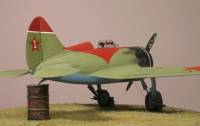 landing,
and high approach speeds, plagued its first year in service. Some pilots simply
refused to fly it. Test pilot team involved in the development program had to
organize a series of demonstration aerobatic flights at different airfields,
to show a true potential of this new aircraft to the units. Only after this
tour de force perception started to change, and with time I-16 turned from most
hated to most loved piece of equipment.
landing,
and high approach speeds, plagued its first year in service. Some pilots simply
refused to fly it. Test pilot team involved in the development program had to
organize a series of demonstration aerobatic flights at different airfields,
to show a true potential of this new aircraft to the units. Only after this
tour de force perception started to change, and with time I-16 turned from most
hated to most loved piece of equipment.
From Spain, over the Far East, and back to Mother Russia, this aircraft spent most of its days with warm gun-barrels. It evolved through series of variants, all of which strangely did not change an overall appearance of agility and ruggedness of this little plane. At the end of its career it looked pretty much the same as at the beginning, with few scoops and hatches added.
True test of will came with Barbarossa, and commencement of the Great Patriotic
War. I-16 was most numerous frontline fighter in Russian service at that time.
No 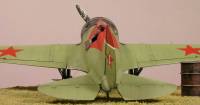 more
capable to match the speed of newest Messerschmitts, I-16 had only its superior
maneuverability to its advantage. Ironically, velocity fighter was no longer
fast enough. Yet, I-16 fought on. Early confrontations produced some high scoring
I-16 pilots. This was also the time of epic battles in most dire conditions,
with aviators running out of ammunition, and ramming their machines into enemies
in desperation. Despite great difficulties I-16 continued to fly in many roles,
and only in the last year of the conflict faded out of the airfields. Its service
spans across ten years. Same ten years in which aviation made its journey from
string-bags to jets. An amazing fact.
more
capable to match the speed of newest Messerschmitts, I-16 had only its superior
maneuverability to its advantage. Ironically, velocity fighter was no longer
fast enough. Yet, I-16 fought on. Early confrontations produced some high scoring
I-16 pilots. This was also the time of epic battles in most dire conditions,
with aviators running out of ammunition, and ramming their machines into enemies
in desperation. Despite great difficulties I-16 continued to fly in many roles,
and only in the last year of the conflict faded out of the airfields. Its service
spans across ten years. Same ten years in which aviation made its journey from
string-bags to jets. An amazing fact.
 First
series (although small) of I-16 to see production was called Type-4. This was
due to the simple fact that Zavod-21 (factory) was already producing three other
aircraft types of different design. In consequence, later variants of I-16 simply
continued with the numbering system.
First
series (although small) of I-16 to see production was called Type-4. This was
due to the simple fact that Zavod-21 (factory) was already producing three other
aircraft types of different design. In consequence, later variants of I-16 simply
continued with the numbering system.
Type-4 was quickly superseded by much improved Type-5. It incorporated a major
redesign of engine cowling, which will define a characteristic look of this
fighter for the rest of its life, with front cooling louvers, radial exhaust
pipes coming out on the circumference of the cowling, and a silver clamp-band
around it. It maintained the original enclosed forward-sliding canopy and a
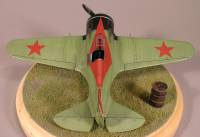 telescopic
gun-sight, as well the full span ailerons. Type-5 stayed in production for several
years with further modifications made in 1938.
telescopic
gun-sight, as well the full span ailerons. Type-5 stayed in production for several
years with further modifications made in 1938.
Particular aircraft that I wanted to model was "White 1", belonging to 33 IAP Regimental Commander Pavel Petrov, photographed during 1940. Big red spearhead painted on top of the fuselage exemplifies really well the influence of art deco in "Soviet glory period". Profile of this aircraft appears in Erik's article about Type-5 colors, and when I first saw it something told me that it will be on my shelf one day.
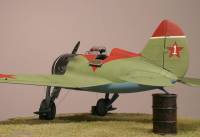 What
really made this project possible is the series of aftermarket sets produced
by Airwaves, aimed at correcting generic I-16 Hobbycraft / Academy kit in 1:48
scale. So far, Airwaves came out with: Type-5, Type-10, Type-29, and Cockpit
Detail sets. I incorporated two of this sets to make an accurate model of Petrov's
aircraft.
What
really made this project possible is the series of aftermarket sets produced
by Airwaves, aimed at correcting generic I-16 Hobbycraft / Academy kit in 1:48
scale. So far, Airwaves came out with: Type-5, Type-10, Type-29, and Cockpit
Detail sets. I incorporated two of this sets to make an accurate model of Petrov's
aircraft.
Usually, the work would start in the cockpit, but my mailman arrived with the Type-5 conversion first, so I started to hack on the airframe. Hobbycraft kit doesn't really represent any particular variant of this aircraft. It is rather a medley of details from different I-16's in one box. To make an accurate early Type-5, one would have to make a serious scratch-building effort, or use the Airwaves set.
For details on installing this set please refer to my review, "The Airwaves I-16 Type 5 Set And What To Do With It".
Once the main operation with resin was over, I continued to modify the exterior
of the airframe. Type-5 had access door for the pilot only on the port side
of the fuselage. It also did not have a radio. Starboard side door, and the
radio hatch on the same side of the fuselage had to be deleted. I-16 had its
instrument panel 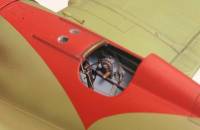 buried
quite a far way under the front deck of the cockpit. To allow for some light
to come in, two circular cutouts were present through the top of the fuselage,
just in front of the instrument panel. On Type-5 aircraft these two holes were
covered with glazing, as they were "in the open wind", when the canopy
was closed. I first drilled out a pair of holes in the fuselage, used cylindrical
cuts form a clear sprue to superglue in these holes, and then sand, and polish
them flush with the fuselage surface. The result is very convincing. I also
created rails for the sliding canopy from lengths of Evergreen rectangular plastic
strips, and added leather padding on the front edge of the cockpit opening,
made from electric wire insulation.
buried
quite a far way under the front deck of the cockpit. To allow for some light
to come in, two circular cutouts were present through the top of the fuselage,
just in front of the instrument panel. On Type-5 aircraft these two holes were
covered with glazing, as they were "in the open wind", when the canopy
was closed. I first drilled out a pair of holes in the fuselage, used cylindrical
cuts form a clear sprue to superglue in these holes, and then sand, and polish
them flush with the fuselage surface. The result is very convincing. I also
created rails for the sliding canopy from lengths of Evergreen rectangular plastic
strips, and added leather padding on the front edge of the cockpit opening,
made from electric wire insulation.
Some surface paneling detail was made of brass sheet, cut to shape and then glued on, instead of just having the 2D panel lines, this was done for the oil tank filler cap on top of the cowling, the cowling band, wing outer section fastener, and some other miscellaneous panels. Rows of rivets were added on the cowling, and inner wing panels.
I wanted to depict a typical droop of elevators, present on literarily all pictures of I-16s at rest. I also wanted to reposition the ruder slightly. As I was working on cutting these surfaces and repositioning them, I realized that rib detail of the tail surfaces is lame, when compared to the rest of airframe that was now very accurate.
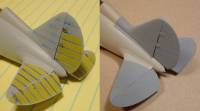 At
this point I was still feeling fresh into the project, and having a reserve
for stretching, so I decided to rebuild this detail completely, using a trick
I learned from Aleksej, of Gremlin Models. First part was to sand smooth all
the tail surfaces. Next step was a time consuming one, and included masking
off accurate ribbing detail in negative using strips of Tamiya masking tape.
At
this point I was still feeling fresh into the project, and having a reserve
for stretching, so I decided to rebuild this detail completely, using a trick
I learned from Aleksej, of Gremlin Models. First part was to sand smooth all
the tail surfaces. Next step was a time consuming one, and included masking
off accurate ribbing detail in negative using strips of Tamiya masking tape.
After this was done, I sprayed some neutral gray color in thick layers, so that when I removed the masks it produced nice 3D rib effect, similar to the one present on the wing and ailerons. One more layer of gray over the whole tail served to smooth all the edges.
 Hobbycraft
kit includes M-25 engine which is decent enough, considering that it will be
hidden in good part under the front cowling. The problem was that I used mine
for I-153 built two years ago. So I used "Engines & Things " Shvetsov
unit that is a slight improvement over the kit part, but can be made into a
really nice looking radial engine with some scrap plastic and copper wire.
Hobbycraft
kit includes M-25 engine which is decent enough, considering that it will be
hidden in good part under the front cowling. The problem was that I used mine
for I-153 built two years ago. So I used "Engines & Things " Shvetsov
unit that is a slight improvement over the kit part, but can be made into a
really nice looking radial engine with some scrap plastic and copper wire.
I also used excellent vac-form acetate canopy from Falcon, because one in the kit was a bit on the absurd side.
 Main
landing gear needed some attention as well. I detailed wheels with some rivets
along the rim, and rebuilt the covers completely, with structure made out of
Evergreen stock, thin wire, syringe tubing and such. I used available photos
to work from, and ended up with something that can pass closer inspection.
Main
landing gear needed some attention as well. I detailed wheels with some rivets
along the rim, and rebuilt the covers completely, with structure made out of
Evergreen stock, thin wire, syringe tubing and such. I used available photos
to work from, and ended up with something that can pass closer inspection.
I also opened up a trapezoidal window in the back wall of the right wheel well, and covered it with acetate sheet. This opening offered quite limited view to the pilot, of what was below him in critical moments of landing.
 Just
when I started to despair, mailman arrived again. This time a cockpit set was
packed in a box, and not a minute to early. Airwaves cockpit is once again done
mostly in light tan resin, but there are also small bits in white metal. This
set is beyond comparison with whatever was originally in the box. I will let
images speak for themselves.
Just
when I started to despair, mailman arrived again. This time a cockpit set was
packed in a box, and not a minute to early. Airwaves cockpit is once again done
mostly in light tan resin, but there are also small bits in white metal. This
set is beyond comparison with whatever was originally in the box. I will let
images speak for themselves.
At this point two fuselage halves were already glued together, which meant that I would have to install the cockpit through the bottom opening of the wing area. But this didn't seem to be very hard; after all, people build ships in bottles don't they? As a matter of fact, design of the set made this task really easy. I first inserted main fuselage frame behind the pilot's seat into the fuselage cavity, and fixed it there with CA glue.
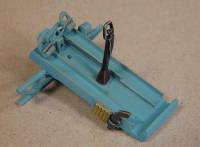
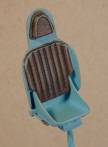 This
helped to align side panels that wrap under the partial floor element, which
also anchors on mentioned fuselage frame. After a bit of adjusting everything
seemed to fit well, so I painted all the separate bits, applying some washes
and dry-brushing to make it all come alive. Interiors of I-16 were commonly
painted with undersurface color of the time (if not left unpainted), this being
rather bright shade called AII Blue. I mixed this myself, trying to follow the
hints given by guru Erik.
This
helped to align side panels that wrap under the partial floor element, which
also anchors on mentioned fuselage frame. After a bit of adjusting everything
seemed to fit well, so I painted all the separate bits, applying some washes
and dry-brushing to make it all come alive. Interiors of I-16 were commonly
painted with undersurface color of the time (if not left unpainted), this being
rather bright shade called AII Blue. I mixed this myself, trying to follow the
hints given by guru Erik.
Few bits that came in white metal form are: telescopic gun-sight, nitrogen and oxygen bottles, ruder pedals, control stick, flare pistol, as well as small levers for different controls left and right (I replaced these with spares from photo-etched bin, for more "to the scale" appearance). I turned both bottles, and the gun-sight using my Dremel as the lathe, with sand-paper pressed against their surface, to clean them up and improve cylindricity. The gun sight needed some more work to bring to the standard. I made forward "spider-leg" supports from the copper wire, and the oval canopy seal from the brass sheet, cut and bent to shape. After touch of black paint it looked nice and proper.
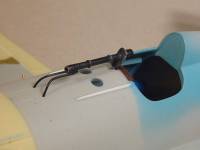
 The
only slight let down of the cockpit set is the instrument panel. There are three
of these, mind you, for different I-16 types, but they all have blank instrument
faces. Now, after all is assembled it won't make a big difference, but it would
be nice if an acetate sheet for instrument faces was included. Well, I would
be dammed to leave it like it is, so I went to make my own instrument mask.
I drilled through holes for all of the instruments with drill bits of the proper
diameter. Then, I laid the piece with its back down on the sheet of sand paper,
and sanded off most of its thickness. After this, I scanned this part (face
down) to get a computer image of the instrument placement. Using the magnified
image, I created simple instrument faces in a program for manipulating bitmaps,
"MS-Paint". After this is finished, I printed the scaled version of
this mask on a glossy photo paper. When the print dried, I applied a cote of
"Future", for that reflective glass look. Now, all that is left is
to paste that mask on the back of pre-painted resin panel, just like with photo-etched/acetate
combination. Voila, home made instrument panel! This process may sound complicated
but its actually very easy to do (if one has a computer).
The
only slight let down of the cockpit set is the instrument panel. There are three
of these, mind you, for different I-16 types, but they all have blank instrument
faces. Now, after all is assembled it won't make a big difference, but it would
be nice if an acetate sheet for instrument faces was included. Well, I would
be dammed to leave it like it is, so I went to make my own instrument mask.
I drilled through holes for all of the instruments with drill bits of the proper
diameter. Then, I laid the piece with its back down on the sheet of sand paper,
and sanded off most of its thickness. After this, I scanned this part (face
down) to get a computer image of the instrument placement. Using the magnified
image, I created simple instrument faces in a program for manipulating bitmaps,
"MS-Paint". After this is finished, I printed the scaled version of
this mask on a glossy photo paper. When the print dried, I applied a cote of
"Future", for that reflective glass look. Now, all that is left is
to paste that mask on the back of pre-painted resin panel, just like with photo-etched/acetate
combination. Voila, home made instrument panel! This process may sound complicated
but its actually very easy to do (if one has a computer).
Assemble everything, sand, polish, prime, sand, and polish again...
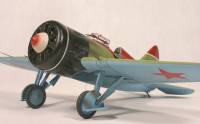 Erik,
a compassionate soul that he is, offered help even when decals were concerned,
and printed two tail stars with white no. 1 on them. In the mean time I managed
to find appropriately sized number 1 in my spare-decals pile, and after all
decided to spray paint the stars (unappreciative bastard that I am), mainly
to be able to color match with the red spearhead. So, everything on the model
except the white number 1 on the ruder is masked and airbrushed. Red flash on
the vertical tail should actually be a slightly darker shade, but on most of
my photos, this in unnoticeable.
Erik,
a compassionate soul that he is, offered help even when decals were concerned,
and printed two tail stars with white no. 1 on them. In the mean time I managed
to find appropriately sized number 1 in my spare-decals pile, and after all
decided to spray paint the stars (unappreciative bastard that I am), mainly
to be able to color match with the red spearhead. So, everything on the model
except the white number 1 on the ruder is masked and airbrushed. Red flash on
the vertical tail should actually be a slightly darker shade, but on most of
my photos, this in unnoticeable.
Otherwise, shades for AII Blue (bottom) and AII Green (top) were mixed at home, and after first application tweaked slightly to come back second time, and add some depth at places.
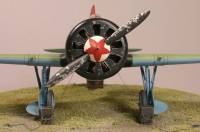 I
read somewhere about a technique of achieving chipped paint by applying wet
salt over pre-painted silver surface, and then airbrushing main color. Dry salt
can be easily removed to expose chipped bits. It sounded crazy enough to try,
so the propeller and the canopy frame were done in this way. Later, I would
use the same technique for discoloration of rusty oil drum. I am pretty happy
about the whole affair.
I
read somewhere about a technique of achieving chipped paint by applying wet
salt over pre-painted silver surface, and then airbrushing main color. Dry salt
can be easily removed to expose chipped bits. It sounded crazy enough to try,
so the propeller and the canopy frame were done in this way. Later, I would
use the same technique for discoloration of rusty oil drum. I am pretty happy
about the whole affair.
Idea to build a base came after finding several photos of I-16 with its tail propped, so that the fuselage is leveled. I liked the looks of it, and thought that a rusty fuel drum as a tail prop, and a pair of wheel chocks may add right amount of character.
The fuel drum was made from brass sheet, rolled around a pen, with copper wire for the drum rings. I also added some small dings to its surface. The drum has a pin in the bottom, with which it can be secured in two different places on the base (where I drilled the holes). Now I am able to display the model propped on the oil drum, or resting on the ground, with the drum standing next to it.
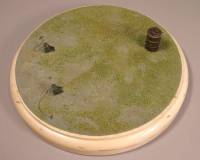 Wheel
chocks were made like little boxes of plastic, with half rings in the front
made from copper wire. Again, shape corresponds to the one seen on photos. I
roughly sanded them, painted them black, and then weathered them with browns.
Wheel
chocks were made like little boxes of plastic, with half rings in the front
made from copper wire. Again, shape corresponds to the one seen on photos. I
roughly sanded them, painted them black, and then weathered them with browns.
The biggest challenge was the grass, as I never did this before. I bought two bags of "railroad grass" of different color, one fine, one course. In retrospect, I would get only the fine one next time, as only that really looks good in 1:48 scale. I also discovered that hairspray is much better bonding agent for grass then recommended white glue. Just don't let my wife know... Once fixed to the base, I dry-brushed different shades over the grass to achieve more natural look. Not bad for the first time...
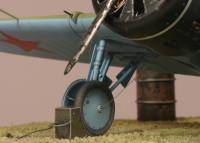 This
particular I-16 early Type-5 turned out to be much, much more than a simple,
and quick build. It rather became a proof that you can condense a lot of attention
and detail in a very small volume, while keeping most of it appreciable, and
visible!
This
particular I-16 early Type-5 turned out to be much, much more than a simple,
and quick build. It rather became a proof that you can condense a lot of attention
and detail in a very small volume, while keeping most of it appreciable, and
visible!
Airwaves accessories hold same essential importance to this Hobbycraft kit, as plastic surgery holds to Hollywood film industry. And I will venture to say that using the first-mentioned combination produces much more authentic and satisfying result, than ... well the second mentioned case.
I would like to thank Erik Pilawskii for all of his knowledge and help, and
endless patience in answering my questions. In the same manner, I am really
grateful to Pete Vill, who firstly mastered these sets, and then spared one
copy for my mailman. He also continues to build my expectations for  English
beer, and I just hope that it will live up to it. Finally, kudos to Airwaves
for tackling subjects that so many others like to ignore.
English
beer, and I just hope that it will live up to it. Finally, kudos to Airwaves
for tackling subjects that so many others like to ignore.
After all that has been written, I ran out of words to put here, and "Happy Modeling" is becoming such a cliché... so 'till the next time,
Don't misbehave...
A